#canebrake
Text
listen one of the major reasons i care so much about Arundinaria is that she's gotta be legit the most exciting rising star in the evolutionary world.
Flowering plants emerge like 100mil years ago, proceed to become the baddest bitches on planet earth with hundreds of thousands of species found in every environment.
from this lineage emerges the GRASS which, using the simple technologies of "Grow leafs from the bottom so the tops can get eaten and you can just keep a-goin'" and "Not die when stepped on" become the undisputed masters of the sunny and arid regions
From the lineage of the GRASSES. Emerges a grass that decides to step up its game and invent WOOD to become some sort of fucked up tree. This grass is known as WOODY BAMBOO and it kicks everybody's ass.
The woody bamboo is mostly thriving in Asia, but around 2mil years ago, a bamboo got LOST AS FUCK and accidentally went to NORTH AMERICA. It turns out the south-eastern part of North America is a downright luxurious climate for a bamboo and so the bamboo actually evolved into its own genus.
However, there was an ICE AGE that froze a bunch of North America and the bamboo was forced to a tiny edge of the Gulf Coast. Fortunately, the bamboo made a mutualistic symbiosis with HUMANS, which used controlled burning to create its ideal habitats in exchange for using the stems for a super-strong, versatile, flexible, water resistant material for literally everything. So basically it spread all throughout the Southeast of North America and formed its own habitat type, a bamboo forest environment known as a CANEBRAKE.
It's native North American bamboo, y'all. It's been reduced to 2% of its former extent and a lot of people don't even know it exists.
This plant is going places we can't let this shining streak of weird-ass plants with ideas just strange enough to work collapse because of a freak colonialism incident
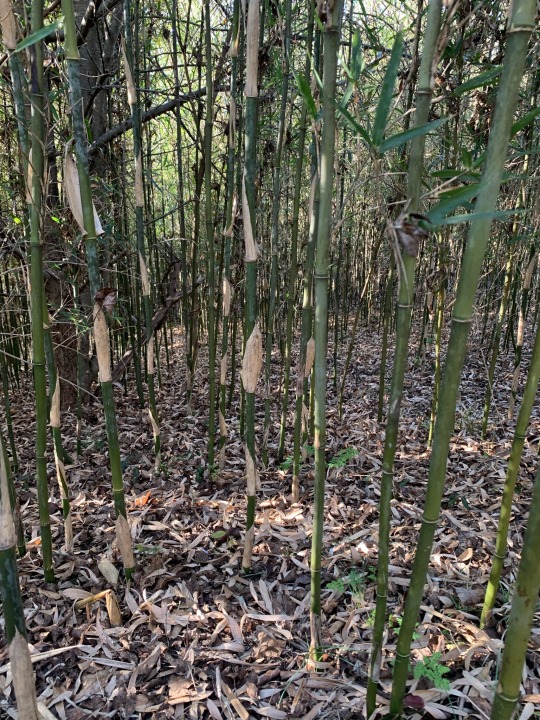
Arundinaria gigantea my absolute beloved
2K notes
·
View notes
Text
Headspace hotel has infected me with the tism about canebrakes, mostly in the searching for content and not finding any
4 notes
·
View notes
Text
Easement
I did not see a parakeet. Nor did I expect to because the last time anyone saw the kind I could have seen was one hundred years ago. But had I seen one, it would have had a green body, a yellow neck, and a red crown, like a granny smith apple, turning into a golden delicious, ending with a fuji flourish. Unlike apples though, this parakeet would have been indigenous. Back in his day, Audubon fixed four of them, all on a branch of matured cocklebur, their name swirling below–Carolina Parrot or Parakeet—just as live ones would have swirled above and outside his page, until they all passed (a century later) into life only re-presented (drawings, pictures, reminiscence, taxidermy).[1] So, I did not see a parakeet.
But I did see cane, as I was in a canebrake. Switchcane, rivercane and hill cane, the genus Arundinaria trio, bamboos native to North America. I am not sure which species of cane I was in, though my guess is switchcane (A. tecta), as rivercane (A. gigantea) also has the name of giant cane for its remarkable height—at maturity it is taller than a grown man on a grown horse; and hill cane (A. appalachiana) has a topographic preference that did not describe the place where I stood.

Nevertheless, they all look similar, more like plants in diagram rather than plants in dirt, their linear stems appear pencil drawn, their lance like leaves seem generated by straight edge. Enmassed, canebrakes look like early computer-generated greenery before sinuosity was possible. In a way, they are an early plant—a fire rolls through, clears the understory, perhaps takes a tree or two down with it; the flames cease and cane is among the first to resurface, and resurface quickly for it is not as dependent on reseeding as it is on its rhizome.[2] Like the longleaf pines which it once accompanied over the land, it looked forward to the fire next time. Out of the flames came thickets, which though they may have barred other plants, they were quite welcoming to Carolina parakeets, warblers, “cougars, bobcats and wolves” canebrake rattlesnakes, creole pearly eye butterfly and untold others.[3] Walls of cane were a kind of mass housing for the many migrant, squatter and settling organisms of the southeast. They (particularly river cane) also provided materials of home and place making for humans, as their straight stems were (and still are) gathered by Native American communities especially the Cherokee.[4] Once hollowed out, canes can become basket or blowgun, mat or flute, or—as has become a rustic object— fishing poles. There are not many significant canebrakes today. Cattle ate them, draining and development cleared them, fire suppression stymies their return; the scattered groupings I see along the road are remnants of a lost empire, holding out amidst a concrete ground that stifles them, a dense forest that smothers them, and farmland that suppresses them. But unlike the parakeet they remain. Though, like the parakeet, I was not in the canebrake to see the cane—it fortunately just happened to be there.
I only saw the canebrake, because I was in a conversation easement, which I only noticed because of a small, yellow, all caps sign—"NORTH CAROLINA SOIL AND WATER CONSERVATION EASEMENT BOUNDARY”. “Easement” is one of those legal terms that I knew more by general use than specific meaning. Modified by the word “conservation” easement suggested the land was protected, but why, by who and to what extent was unclear until I looked it up later. The NC Department of Environmental Quality defines conservation easements as: “voluntary legal agreements designed to ensure the long-term viability and protection of the natural resources within a surveyed and recorded boundary. The easement planning process establishes allowances and restrictions that are beneficial to the landowner, the easement holder, and the environment.”[5] The conservation easement then is not foremost a means of protection, but (much more interesting I think), it is a way of organizing layers of rights and access upon a property. Someone owns the lands, but the easement gives some else a right to use it (or not use it, in a way, when conservation is the right being exercised) which in turn inflects the rights and possibilities of both the one who possess the land and others (like myself) who neither own the land, nor hold an easement, but still gain some benefit from the easement’s existence (i.e. enjoying a now rare landscape feature).[6] The yellow sign that alerted me to presence of the easement was nailed into a sweet gum tree. In the FAQ for conservation easements one of the questions asks: “Are there way to precisely identify the boundaries of a conservation easement?”
The answer:
As part of the restoration project, all easement corners were surveyed and monumented in the ground with metal rods. Most of these rods are also topped with 2” diameter aluminum caps. DEQ also uses a variety of methods to post easement boundaries including signage, metal posts, and tree blaze. These may be a witness post or witness tree, located near the line but not the exact location of the boundary.[7]
In some ways, my studies right now could be described as figuring out the extra-legal work of these “witness trees” and their “artefacted” forms into “witness posts” (and columns and panels and all sorts of other wooden things that “witness” human contracts and contact).[8] It gave me pause then, after reading the FAQ to realize that I had witnessed a witness tree that still witnesses (instead of being one in a historical document or text), but that in the moment the sweet gum’s legal function had not even registered to me. I was much more taken by the train of ants along its trunk likely extracting honeydew from aphids up in the canopy, and by the trail of Virginia creeper going up further than the ants, in search of its own luminous food. From the tree’s perspective, witnessing a survey has been only one frame in a very long film still being made around, and around and around it.
In truth, I did even see the easement sign until I was near the tree. And the reason I was near the tree is because a few feet away from it, along the road was the initial object of my attention—a set of black and yellow object marker signs denoting some feature adjacent to the road, a feature which is this case was a culvert underneath the road. Culverts, in their projecting pipe form look like engineering/infrastructural litter, debris left over from a drainage project. In addition to being the ugliest kind they are also the cheapest and least efficient—they do little to channel a flow directly into their opening, which limits how much comes out their exit, potentially leading to the water overflowing the road. Luckily, the culvert I came to see is the recessed box kind with wings extending on its side to welcome water into its inlet, guiding it towards its outlet.[9] Embedded in the earth, moss covered, and a bit worn, there is a minimalist beauty to this kind culvert that does not readily betray the complexity of its task at once to convey ground traffic above and the traffic of water underneath. On the outlet side, some of the water pooled, its clear bottom supported small fish and tadpoles, while its silty edge moistened mosses and grasses and a bit further up also the canes. The water this culvert channels comes from the Indian Branch River, which drains into Deep Creek River, which drains into the Tar River, which drains into the Pamlico Sound, which joins the Atlantic Ocean. Follow these larger waters and you’ll find the larger history of the canes and the Cherokees, the parakeets and the many trees which have witnesses the work of so many kinds of settling, the human version being the most recent, but likely not the last. Though we often like to think otherwise, our homes and other feats of building are ultimately done under a kind of “natural easement”, the land allows us access for a while, but as all the other prior communities of plants or persons show, no claim of possession is final, no root is long and deep enough to always remain (though many can be long remnant). Maybe I will be able to spend a good deal of my life following these state and nation spanning roots, weavings, waters and rhizomes.
But it is not yet time to go so far out. Afterall, the only reason I saw the signs for the culvert, which put me in range to see the blaze on the tree, which brought me close enough to see a canebrake, which led me to imagine what it would be like to still be able to see parakeets, was because I pass the culvert nearly every day when I am home. Fifteen hundred feet from the front door, I have crossed this place many times running, enjoying the brief respite of shade provided by the gums before the land opens again for the farms; and I have driven by it many more times on the way to town, the car bouncing lightly over the culvert. So, I have noticed this spot for nearly thirty years, but this is first time I have “witnessed” the three hundred years of history flowing and growing in it. Either part separately is valuable—to live in a place and feel its features or to come to a place and learn its features, nesting sensations (the shade of the trees, the bump of the road…) or nesting histories (extinction, settlement…). But to bring them together, may, for a moment sustain that special sense which is just able to catch an apple-colored dart zipping across the far end of the eye.
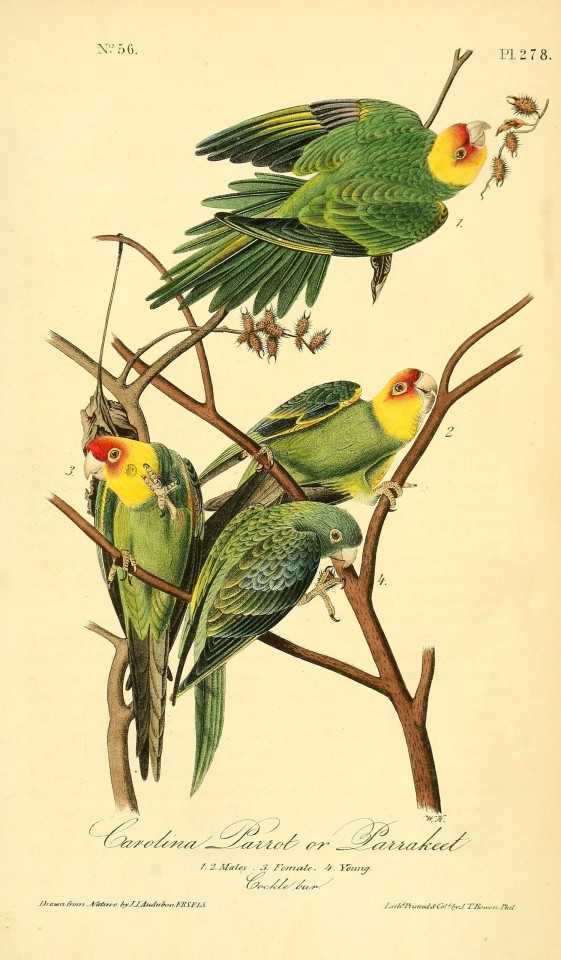
Photos
[1] The Carolina Parakeet, once common from New York down to the Gulf of Mexico, seems to have gone in the first half of the 20th century. The last documented one, named Incas, died in captivity in 1918. It is unclear exactly why it went extinct though habitation destruction seems part of the problem. See: https://johnjames.audubon.org/last-carolina-parakeet and https://www.smithsonianmag.com/science-nature/why-carolina-parakeet-go-extinct-180968740/
[2] There is strong interest in canes and restoring canebrakes. For a general overview see: Barret, Richard; Grabowski, Janet; Williams, M.J. "Giant Cane and Other Native Bamboos: Establishment and Use for Conservation of Natural Resources in the Southeast" U.S. Department of Agriculture, Natural Resources Conservation Service, 2021. For a 18th account of cane use in North Carolina see: Lawson, John. A New Voyage to North Carolina. London: 1709. Digitized at https://docsouth.unc.edu/nc/lawson/menu.html. Lawson recorded many ways that cane was used by the Cherokee.
[3] See: Platt, Steven G., Christopher G. Brantley, and Thomas R. Rainwater. “Canebrake Fauna: Wildlife Diversity In A Critically Endangered Ecosystem.” Journal of The Elisha Mitchell Scientific Society 117, No. 1 (2001): 1–19.
[4] For contemporary work to maintain these traditions see: https://theonefeather.com/2012/05/22/river-cane-important-cherokee-cultural-staple/
[5] See: https://www.deq.nc.gov/about/divisions/deq-administrative-divisions/north-carolina-stewardship-program/living-your-conservation-easement#Aretherewaystopreciselyidentifytheboundariesofaconservationeasement-8672
[6] Though my enjoyment in this case was not a right because this easement is not public (i.e., I was trespassing).
[7] See link on note 4.
[8] Other have already done some of this work. See for example: Miller, Daegan. This Radical Land. Chicago: University of Chicago Press. 2018.
[9] Here is a wonderfully informative video on culverts: https://www.youtube.com/watch?v=15XJDmawbYU
Images:
Carolina Parrot or Parakeet” in The Birds of America: From Drawings Made in the United States and Their Territories Volume 4. John James Audubon. New York: J.B. Chevalier, 1842. p.306.
Image 3208 (Canebrake in Northeast Louisiana early 1900’s). USDA Bureau of Plant Introduction. See note 2 for source.
4 notes
·
View notes
Text







Two-tone with the Rattler Canebrake
RSB/M | Terra Bronze
HTP XOS 3.5-Slot MLOK Scale | Dragon Texture | Black
HTP XOS-H 3.5-Slot MLOK Scale | Dragon Texture | Black
QDX Sling Mount | Terra Bronze
MCX CSMR Button | Terra Bronze
- RS
#RailScales#HTP#HTP Scales#HTP XOS#NiR Scales#XOS#XOS-H#RSB#RSBM#QDX#CSMR#MCX CSMR#Sig#Sig Sauer#MCX#MCX Rattler#Rattler#Rattler Canebrake#SLH300#SLH300-DT#SLH300 Inconel#Romeo8T#Magpul#Poi Tac#ST-MCX#Steiner DBAL#DBAL-A2#MLOK#Made in USA#Profoto
118 notes
·
View notes
Text

[2027/11056] Canebrake groundcreeper - Clibanornis dendrocolaptoides
Order: Passeriformes
Suborder: Tyranni
Family: Furnariidae
Photo credit: João Vitor Andriola via Macaulay Library
#birds#Canebrake groundcreeper#Passeriformes#Tyranni#Furnariidae#Clibanornis#birds a to z#undescribed
87 notes
·
View notes
Text
2024 is the year I start applying all my hobbies for practical use
plants -> foraging
painting/sculpture -> car repair
fish -> aquaculture
i am about to get my hoosier on fuck this stupid city life im getting in the dirt
#text#i wanna cultivate clams and mussels and canebrake and trout literally give me a piece of the river i can fix it
4 notes
·
View notes
Photo

A new variant has been added!
Canebrake Wren (Cantorchilus zeledoni)
© Steven Easley
It hatches from black, bold, bright, brushy, few, plain, quick, rich, rusty, short, small, western, white, and whitish eggs.
squawkoverflow - the ultimate bird collecting game
🥚 hatch ❤️ collect 🤝 connect
2 notes
·
View notes
Text
"
It started with a few sentences in a book I was reading about the history of the Appalachian Mountains. The book briefly discussed Kentucky, before colonization, being covered with dense thickets called canebrakes, which mostly disappeared when settlers plowed and cleared the fertile bottomlands where they grew. “Cane,” the book claimed, was likely the origin of the name Kentucky—“Kain-tuck.”
“Cane” was just what the settlers called the tall, woody plant that dominated in canebrakes—the name refers to any of the three similar plant species belonging to the genus Arundinaria. In Kentucky, it was most likely A. gigantea, or giant river cane. Giant river cane has no relationship to plants like sugar cane, and are actually North America’s only native bamboo.
Bamboo? In Kentucky?
I recalled having seen some strangely bamboo-like plants in the area, including a large patch in an empty lot close to my house. My memory rushed back to several years ago, when my brother had been camping in a “bamboo forest” along a creek that bordered a farm. How strange, I had thought. Who would plant bamboo in the middle of nowhere like that?
Unless…it was native bamboo?"
0 notes
Text
In my universe the batman expy(s) are kinda the bad guys (needlessly violent, territorial, nosy, and smug)
#the family is called Gatecrash and the word Gatecrash is now slang for a person who displays these traits#most people hate them#need names for them but one of them is called Canebrake Gatecrash (aka cane/cain) and he sucks
0 notes
Text
so my quest now is to get Arundinaria federally listed as endangered because I think the evidence is highly compelling
it's declined to less than 2% of its original range
it used to be a keystone species in an ecosystem that included Bachman's warbler, passenger pigeons and Carolina parakeets, all extinct now
Currently canebrakes are major habitat for several endangered or critically endangered plants including Venus flytraps and Alabama canebrake pitcher plants
it grows in large clonal colonies and reproduces sexually only every 30-40 years. this means that existing genetic diversity could be incredibly low.
(Personal observation) very, very few existing examples of rivercane are large, robust, and healthy canebrakes. like, most photos and observations I can find are of little, twiggy canes growing as part of the underbrush in a forest.
My canebrake has no canes that look like that. The shortest canes are 4-6 feet tall. But it's not declining—it's healthy looking and on the ground there are tiny sprouts nudging up from the rhizomes. ALSO. I found an old photo of the canebrake, from June 2020. It was like. Half the size. I am certain the river cane was not this tall and striking in the spring. I go on walks daily in the neighborhood; I would have noticed it.
I hypothesize that as a canebrake expands and matures, its growth rate increases, so a "mature" canebrake can shoot up 6+ foot canes in a single growing season. Existing research by the few organizations working on canebrake conservation states that after a controlled burn, canes resprout very rapidly from the rhizome system, growing as fast as 1.5 inches a day. Historical records attest that river cane reached 30 or even 45+ feet tall, but there is like, one photo online in existence of cane taller than 15 feet.
What this means is that almost all remaining river cane is in incredibly poor condition, basically existing in a weak immature state. "Maturity" for river cane means a large clonal colony, not a few sparse sticks in the undergrowth. The fact that this plant grows in large clonal colonies is key—if no mature, healthy colonies exist in an area, the plant is almost functionally extinct.
With the rate of development and clearing of land compared next to river cane's slow flowering schedule, it's likely that many clonal colonies are eradicated without ever flowering, meaning that genetic diversity is almost certainly dropping.
Rivercane is dependent on human management via regular controlled burns to thrive. This is not a species that will recover if simply left to itself—if an area of land is left to reforest, the cane will be outcompeted. If it is grazed by cattle, it will be destroyed.
It is already listed as endangered in a couple states
i'm going back to my volunteer job soon, I will bring this proposal, I already know the head forester and ecologist are interested, and i'll be gathering contacts
509 notes
·
View notes
Text
My goblins have been singing a weird song lately. Anybody know if this means they’re planning something?
Some people say a goblin’s made outta mud
A poor gob's made outta muscle and mud
Muscle and mud and skin and bones
A mind that's a-weak and a back that's strong
You load 16 tons, what do you get?
Another day older and deeper in debt
Maglubliyet, don't you call me 'cause I can't go
I owe my soul to the Murderous Gnome
I was born one mornin' when the sun didn't shine
I picked up my drill and I climbed down the mine
I loaded 16 tons of Runic Warp Stone
And the gnome boss said, "Well, a-curse my soul"
You load 16 tons, what do you get?
Another day older and deeper in debt
Maglubliyet, don't you call me 'cause I can't go
I owe my soul to the Murderous Gnome
I was born one mornin', it was drizzlin' rain
Fightin' and shankin’ are my middle name
I was raised in the canebrake by an ol' bird thing lion
Can't no high toned wizard make me walk the line
You load 16 tons, what do you get?
Another day older and deeper in debt
Maglubliyet, don't you call me 'cause I can't go
I owe my soul to the Murderous Gnome
If you see me comin', better step aside
A lotta gobs didn't, a lotta gobs died
One fist of copper, the other of steel
If the right one don't get you
Then the left one will
You load 16 tons, what do you get?
Another day older and deeper in debt
Maglubliyet, don't you call me 'cause I can't go
I owe my soul to the Murderous Gnome
#wizard#wizard shit#wizard tumblr#wizard posting#wizardposting#artificer#gnome#gnome post#goblins#sixteen tons
280 notes
·
View notes
Text
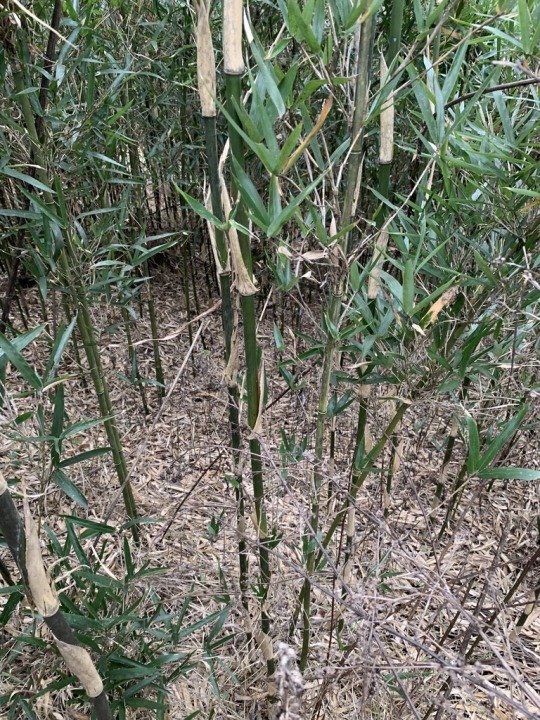



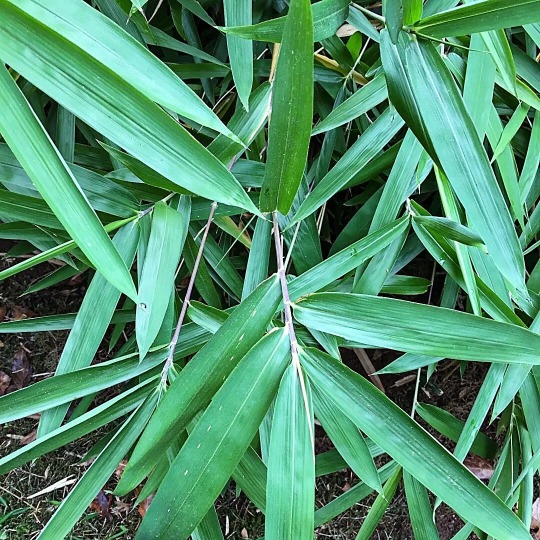
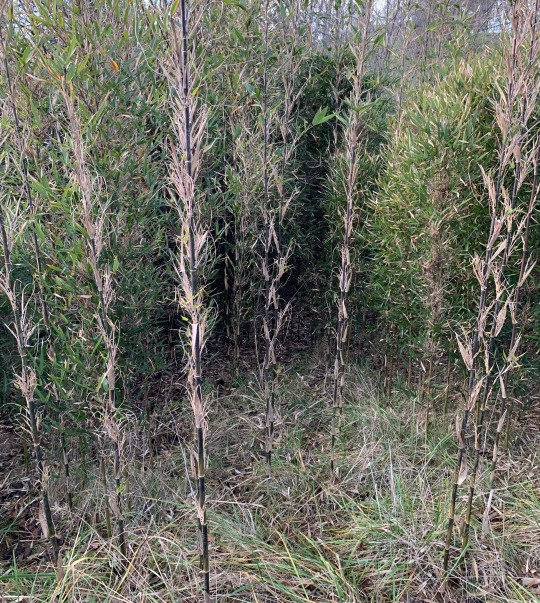
Cool Plant: Arundinaria gigantea
Giant River Cane
This plant is extra special! Not only is it one of three members of the genus Arundinaria, which together are North America's only native bamboo, it also once formed extensive bamboo forests in the American Southeast known as canebrakes, where the bamboo stalks could exceed 30 feet tall! The bamboo forests are thought to have covered 10 million acres of the southeastern United States.
River cane grows in damp areas such as low-lying woods and the edges of creeks, and has incredible abilities for resisting erosion and filtering contaminants from groundwater. It is a fire dependent species, and canebrakes were maintained by Native Americans using controlled burns. Native American peoples such as the Cherokee and the Choctaw used the river cane as a super tough all purpose crafting material for everything from flutes and blowguns to baskets, backpacks, mats and bed frames.
Nowadays, it mostly only exists in small patches along fences and in ditches, where it usually grows no taller than 10 feet or so. Since it grows in large clonal colonies and only produces seeds once before the entire patch dies, it is hard for it to reproduce these days. The destruction of the canebrakes by colonists' cattle, plowing, and neglect of the caretaking practices are thought to have helped drive the Carolina parakeet and passenger pigeon to extinction.
Many other species depend on the Arundinaria bamboos to live: there are at least 9 butterfly and moth species that use it as a host plant, and some of the rarest plants in the Southeast, including the Venus flytrap, are often found in remaining fragments of canebrakes.
202 notes
·
View notes
Text
The Round 1 Draw is here!

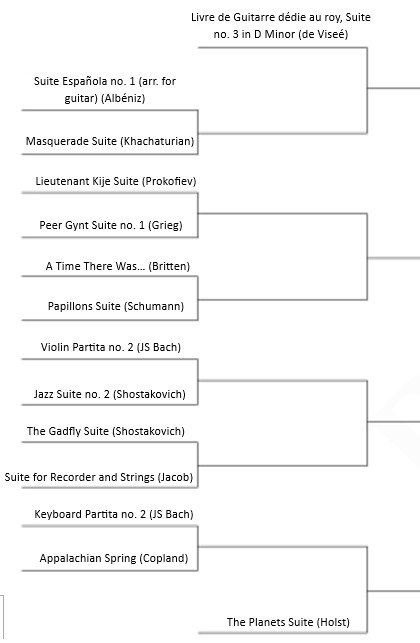

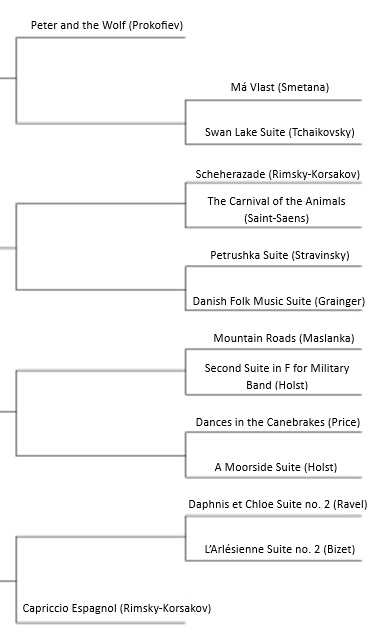
The top left:
Sleeping Beauty Suite vs Bye
Le tombeau de Couperin vs Suite in Old Style
Holberg Suite vs Lemminkäinen Suite
Caucasian Sketches Suite no. 1 vs Suite for Solo Viola
The Golden Mountains vs Carmen Suite no. 2
Lincolnshire Posy vs Der Rosenkavalier Suite
American Suite vs Cello Suite in G Major
Pictures at an Exhibition vs Children's Corner Suite
The bottom left:
Livre de Guitarre dédie au roy, Suite no. 3 in D Minor vs Bye
Suite Española no. 1 vs Masquerade Suite
Lieutenant Kije Suite vs Peer Gynt Suite no. 1
A Time There Was vs Papillons Suite
Violin Partita no. 2 vs Jazz Suite no. 2
The Gadfly Suite vs Suite for Recorder and Strings
Keyboard Partita no. 2 vs Appalachian Spring
The Planets Suite vs Bye
The top right:
Suite from Hamlet vs Bye
English Folk Song Suite vs Mother Goose Suite
Orchestral Suite no. 3 in D vs St Paul's Suite
The Firebird Suite vs Symphonic Dances
Romeo and Juliet Suite No. 2 vs Dance Suite
Giselle Ballet Suite vs Keyboard Partita no. 6
First Suite in E-flat for Military Band vs Magnificant in Bb Major
The Nutcracker Suite vs Violin Partita no. 3
The bottom right:
Peter and the Wolf vs Bye
Má Vlast vs Swan Lake Suite
Scheherazade vs The Carnival of the Animals
Petrushka Suite vs Danish Folk Music Suite
Mountain Roads vs Second Suite in F for Military Band
Dances in the Canebrakes vs A Moorside Suite
Daphnis et Chloe Suite no. 2 vs L’Arlésienne Suite no. 2
Capriccio Espagnol vs Bye
Please note all of these matches (including byes) were randomly allocated using a random number generator and I will not be making any changes. I will post 1 poll per day starting from 12:00 am GMT time on the 1st of December (in 24 hours time at time of posting), with each poll lasting for a week to give everyone time to listen to each submission.
35 notes
·
View notes
Text

[2028/11056] Canebrake wren - Cantorchilus zeledoni
Order: Passeriformes
Suborder: Passeri
Superfamily: Certhioidea
Family: Troglodytidae (wrens)
Photo credit: Daniel Winzeler via Macaulay Library
#birds#Canebrake wren#Passeriformes#Passeri#Certhioidea#Troglodytidae#Cantorchilus#birds a to z#undescribed
37 notes
·
View notes
Text

Timber Rattlesnake (Crotalus horridus), family Viperidae, FL, USA
Venomous.
This color/pattern variety found in the SE United States is called the "Canebrake Rattlesnake". It was once considered to be a subspecies of Timber Rattlesnake, but it is no longer considered to be a valid subspecies.
photograph by Christina Shaffer
54 notes
·
View notes
Text
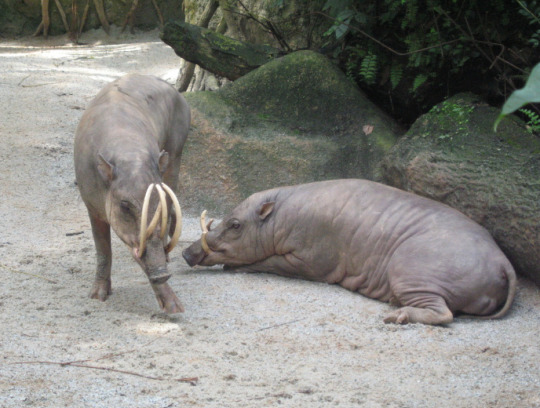
Sulawesi Babirusa (Babyrousa celebensis)
Family: Pig Family (Suidae)
IUCN Conservation Status: Vulnerable
Native to the islands of Sulawesi, Pulau Muna, Butung and Lembeh in Indonesia, the Sulawesi Babirusa is a small, slender, almost entirely hairless species of wild pig best known for the four enormous curled tusks seen in adult males (which are derived from highly elongated canine teeth,) although adult females also possess a single pair of smaller, less elaborate tusks protruding from their lower jaws. The tusks of a male babirusa are used to intimidate rival males and impress potential mates (with females generally preferring males with larger, curlier tusks,) although despite their impressive appearance they are brittle and unsuited for fighting; males generally resolve conflicts through intimidation alone, but if a fight does occur they instead rear up onto their hind legs and strike at each other with their front hooves, similar to a clumsier version of the boxing behaviour of hares. Typically inhabiting dense forests or canebrakes (forest-like areas dominated by tall bamboo of the genus Arundinaria,) members of this species tend to remain near permanent bodies of water such as rivers and large ponds and feed mainly on fallen fruit, although like other pig species they are unspecialised omnivores and will also readily consume leaves, roots and small invertebrates. Female Sulawesi Babirusas live in groups of around 15 adults accompanied by their young, while males are generally solitary outside of the mating season (between January and August). Unlike most pigs females of this species produce only small litters of 1-2 piglets each year, with young being born tuskless and covered in a coat of short, reddish-brown hair.
--------------------------------------------------------------------------
Image Source: https://www.inaturalist.org/taxa/74099-Babyrousa-celebensis
#Sulawesi Babirusa#babirusa#pig#pigs#suidae#zoology#biology#mammalogy#animal#animals#wildlife#Asian wildlife#Indonesian wildlife#ungulates#ungulate#even-toed ungulate#even-toed ungulates#artiodactyla#artiodactyls#wild pig#wild pigs#mammal#mammals
32 notes
·
View notes